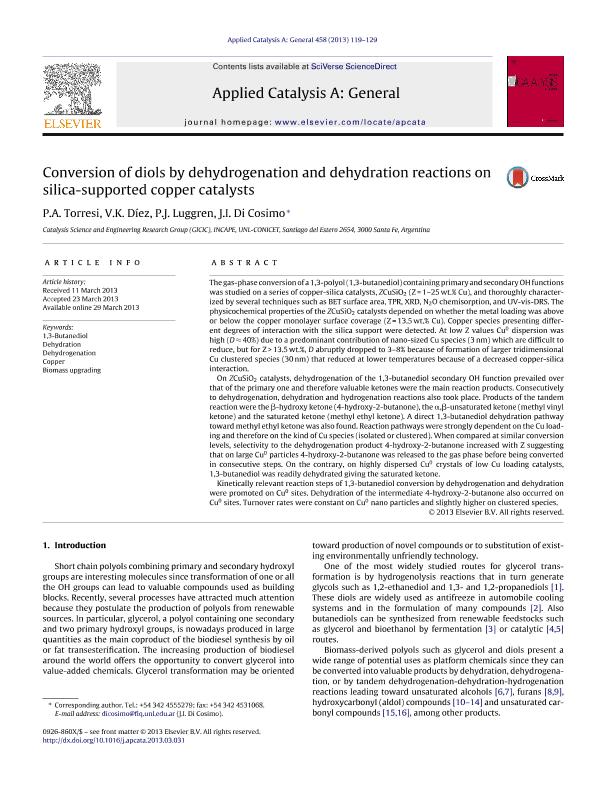Artículo
Conversion of diols by dehydrogenation and dehydration reactions on silica-supported copper catalysts
Fecha de publicación:
05/2013
Editorial:
Elsevier Science
Revista:
Applied Catalysis A: General
ISSN:
0926-860X
Idioma:
Inglés
Tipo de recurso:
Artículo publicado
Clasificación temática:
Resumen
The gas-phase conversion of a 1,3-polyol (1,3-butanediol) containing primary and secondary OH functions was studied on a series of copper-silica catalysts, ZCuSiO2 (Z = 1-25 wt.% Cu), and thoroughly characterized by several techniques such as BET surface area, TPR, XRD, N2O chemisorption, and UV-vis-DRS. The physicochemical properties of the ZCuSiO 2 catalysts depended on whether the metal loading was above or below the copper monolayer surface coverage (Z = 13.5 wt.% Cu). Copper species presenting different degrees of interaction with the silica support were detected. At low Z values Cu0 dispersion was high (D ≈ 40%) due to a predominant contribution of nano-sized Cu species (3 nm) which are difficult to reduce, but for Z > 13.5 wt.%, D abruptly dropped to 3-8% because of formation of larger tridimensional Cu clustered species (30 nm) that reduced at lower temperatures because of a decreased copper-silica interaction. On ZCuSiO2 catalysts, dehydrogenation of the 1,3-butanediol secondary OH function prevailed over that of the primary one and therefore valuable ketones were the main reaction products. Consecutively to dehydrogenation, dehydration and hydrogenation reactions also took place. Products of the tandem reaction were the β-hydroxy ketone (4-hydroxy-2-butanone), the α,β- unsaturated ketone (methyl vinyl ketone) and the saturated ketone (methyl ethyl ketone). A direct 1,3-butanediol dehydration pathway toward methyl ethyl ketone was also found. Reaction pathways were strongly dependent on the Cu loading and therefore on the kind of Cu species (isolated or clustered). When compared at similar conversion levels, selectivity to the dehydrogenation product 4-hydroxy-2-butanone increased with Z suggesting that on large Cu0 particles 4-hydroxy-2-butanone was released to the gas phase before being converted in consecutive steps. On the contrary, on highly dispersed Cu 0 crystals of low Cu loading catalysts, 1,3-butanediol was readily dehydrated giving the saturated ketone. Kinetically relevant reaction steps of 1,3-butanediol conversion by dehydrogenation and dehydration were promoted on Cu0 sites. Dehydration of the intermediate 4-hydroxy-2-butanone also occurred on Cu0 sites. Turnover rates were constant on Cu0 nano particles and slightly higher on clustered species.
Palabras clave:
1,3-Butanediol
,
Biomass Upgrading
,
Copper
,
Dehydration
,
Dehydrogenation
Archivos asociados
Licencia
Identificadores
Colecciones
Articulos(INCAPE)
Articulos de INST.DE INVEST.EN CATALISIS Y PETROQUIMICA "ING. JOSE MIGUEL PARERA"
Articulos de INST.DE INVEST.EN CATALISIS Y PETROQUIMICA "ING. JOSE MIGUEL PARERA"
Citación
Torresi, Pablo Antonio; Diez, Veronica Karina; Luggren, Pablo Jorge; Di Cosimo, Juana Isabel; Conversion of diols by dehydrogenation and dehydration reactions on silica-supported copper catalysts; Elsevier Science; Applied Catalysis A: General; 458; 5-2013; 119-129
Compartir
Altmétricas




